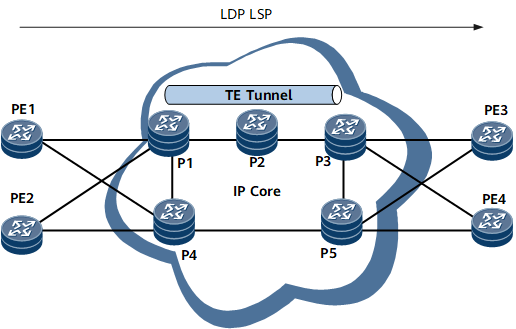LDP over TE
Principles
LDP over TE establishes LDP LSPs across RSVP-TE areas. RSVP-TE is an MPLS tunnel technique used to generate LSPs as tunnels for other protocols to transparently transmit packets. LDP is another MPLS tunnel technique used to generate LDP LSPs. LDP over TE allows an LDP LSP to span an RSVP-TE area so that a TE tunnel functions as a hop along an LDP LSP.
After an RSVP-TE tunnel is established, an IGP (OSPF or IS-IS) locally computes routes or advertises link state advertisements (LSAs) or link state PDUs (LSPs) to select a TE tunnel interface as the outbound interface. In the following example, the original router is directly connected to the destination router of the TE tunnel through logical interfaces. Packets are transparently transmitted along the TE tunnel.
An RSVP-TE tunnel between P1 and P3 is set up. P3 assigns RSVP-Label-1 to P2, and P2 assigns RSVP-Label-2 to P1.
PE2 initiates LDP to set up an LSP and sends a Label Mapping message carrying LDP-Label-1 to P3.
Upon receipt, P3 sends a Label Mapping message carrying LDP-Label-2 to P1 over a remote LDP session.
Upon receipt, P1 sends a Label Mapping message carrying LDP-Label-3 to PE1.
Usage Scenario
LDP over TE is used to transmit VPN services. Because carriers have difficulties in deploying MPLS traffic engineering on an entire network, they use LDP over TE to plan a core TE area and implement LDP outside this area. Figure 2 illustrates an LDP over TE network.
The advantage of LDP over TE is that an LDP LSP is easier to operate and maintain than a TE tunnel, and the resource consumption of LDP is lower than that of the RSVP soft state. On an LDP over TE network, TE tunnels are deployed only in the core area, but not on all devices including PEs. This simplifies deployment and maintenance on the entire network and relieves burden from PEs. In addition, the core area can take full advantage of TE tunnels to perform protection switchovers, path planning, and bandwidth protection.

